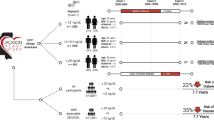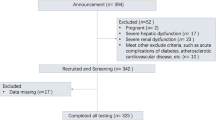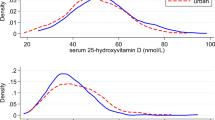Abstract
Data on the association between vitamin D status and actual change in glycemic measures are limited. We examined the prospective association between a predicted 25-hydroxyvitamin D (25(OH)D) score and change in fasting plasma glucose concentration over a mean follow-up of 7 years, in 2571 men and women (mean age 54 years) without diabetes in the Framingham Offspring Study cohort. After adjustment for age, sex, body mass index and fasting plasma glucose at baseline, higher predicted 25(OH)D score at baseline was associated with a smaller 7-year increase in fasting plasma glucose concentrations (0.23 mmol/l versus 0.35 mmol/l for highest versus lowest tertile of 25(OH)D score, respectively, P-trend=0.002). Vitamin D status may be an important determinant for change in fasting plasma glucose concentration among middle-aged and older adults without diabetes.
This is a preview of subscription content, access via your institution
Access options
Subscribe to this journal
Receive 12 print issues and online access
$259.00 per year
only $21.58 per issue
Buy this article
- Purchase on Springer Link
- Instant access to full article PDF
Prices may be subject to local taxes which are calculated during checkout
Similar content being viewed by others
References
Alvarez JA, Ashraf AP, Hunter GR, Gower BA (2010). Serum 25-hydroxyvitamin D and parathyroid hormone are independent determinants of whole-body insulin sensitivity in women and may contribute to lower insulin sensitivity in African Americans. Am J Clin Nutr 92, 1344–1349.
Bao Y, Ng K, Wolpin BM, Michaud DS, Giovannucci E, Fuchs CS (2010). Predicted vitamin D status and pancreatic cancer risk in two prospective cohort studies. Br J Cancer 102, 1422–1427.
Ford ES, Ajani UA, McGuire LC, Liu S (2005). Concentrations of serum vitamin D and the metabolic syndrome among U.S. adults. Diabetes Care 28, 1228–1230.
Forouhi NG, Luan J, Cooper A, Boucher BJ, Wareham NJ (2008). Baseline serum 25-hydroxy vitamin D is predictive of future glycaemic status and insulin resistance: the MRC Ely prospective study 1990 - 2000. Diabetes 57, 2619–2625.
Giovannucci E, Liu Y, Rimm EB, Hollis BW, Fuchs CS, Stampfer MJ et al (2006). Prospective study of predictors of vitamin D status and cancer incidence and mortality in men.[see comment]. J Natl Cancer Inst 98, 451–459.
Jani R, Molina M, Matsuda M, Balas B, Chavez A, DeFronzo RA et al (2008). Decreased non-insulin-dependent glucose clearance contributes to the rise in fasting plasma glucose in the nondiabetic range. Diabetes Care 31, 311–315.
Lee S, Clark SA, Gill RK, Christakos S (1994). 1,25-dihydroxyvitamin D3 and pancreatic beta-cell function: vitamin D receptors, gene expression, and insulin secretion. Endocrinology 134, 1602–1610.
Liu E, Meigs JB, Pittas AG, Economos CD, McKeown NM, Booth SL et al (2010). Predicted 25-hydroxyvitamin D score and incident type 2 diabetes in the Framingham Offspring Study. Am J Clin Nutr 91, 1627–1633.
Maestro B, Campion J, Davila N, Calle C (2000). Stimulation by 1,25-dihydroxyvitamin D3 of insulin receptor expression and insulin responsiveness for glucose transport in U-937 human promonocytic cells. Endocr J 47, 383–391.
Mattila C, Knekt P, Mannisto S, Rissanen H, Laaksonen MA, Montonen J et al (2007). Serum 25-hydroxyvitamin D concentration and subsequent risk of type 2 diabetes. Diabetes Care 30, 2569–2570.
Nagpal J, Pande JN, Bhartia A (2009). A double-blind, randomized, placebo-controlled trial of the short-term effect of vitamin D3 supplementation on insulin sensitivity in apparently healthy, middle-aged, centrally obese men. Diabet Med 26, 19–27.
Need AG, O’Loughlin PD, Horowitz M, Nordin BE (2005). Relationship between fasting serum glucose, age, body mass index and serum 25 hydroxyvitamin D in postmenopausal women. Clin Endocrinol 62, 738–741.
Norman AW (2006). Minireview: vitamin D receptor: new assignments for an already busy receptor. Endocrinology 147, 5542–5548.
Pittas AG, Dawson-Hughes B, Li T, Van Dam RM, Willett WC, Manson JE et al (2006). Vitamin D and calcium intake in relation to type 2 diabetes in women. Diabetes Care 29, 650–656.
Pittas AG, Harris SS, Stark PC, Dawson-Hughes B (2007a). The effects of calcium and vitamin D supplementation on blood glucose and markers of inflammation in nondiabetic adults. Diabetes Care 30, 980–986.
Pittas AG, Lau J, Hu FB, Dawson-Hughes B (2007b). The role of vitamin D and calcium in type 2 diabetes. A systematic review and meta-analysis. J Clin Endocrinol Metab 92, 2017–2029.
Scragg R, Sowers M, Bell C (2004). Serum 25-hydroxyvitamin D, diabetes, and ethnicity in the Third National Health and Nutrition Examination Survey. Diabetes Care 27, 2813–2818.
Soares MJ, Ping-Delfos WC, Sherriff JL, Nezhad DH, Cummings NK, Zhao Y (2011). Vitamin D and parathyroid hormone in insulin resistance of abdominal obesity: cause or effect? Eur J Clin Nutr; e-pub ahead of print 29 June 2011; doi:10.1038/ejcn.2011.111.
von Hurst PR, Stonehouse W, Coad J (2010). Vitamin D supplementation reduces insulin resistance in South Asian women living in New Zealand who are insulin resistant and vitamin D deficient - a randomised, placebo-controlled trial. Br J Nutr 103, 549–555.
Acknowledgements
We are grateful to the Framingham Study participants and staff. We thank Gail Rogers, from Jean Mayer USDA Human Nutrition Research Center, for data management and statistical guidance. The present study was supported in part by the US Department of Agriculture, under agreement No. 58-1950-7-707, and the Framingham Heart Study of the National Heart Lung and Blood Institute of the National Institutes of Health (Contract No. N01-HC-25195), and by an American Diabetes Association Career Development Award (JBM), NIDDK K24 DK080140 (JBM), R01DK076092 and R21DK078867 (AGP), NIA AG14759 (SLB), and the Beverage Institute for Health and Wellness (CDE).
Author information
Authors and Affiliations
Corresponding author
Ethics declarations
Competing interests
The authors declare no conflict of interest.
Rights and permissions
About this article
Cite this article
Liu, E., McKeown, N., Pittas, A. et al. Predicted 25-hydroxyvitamin D score and change in fasting plasma glucose in the Framingham offspring study. Eur J Clin Nutr 66, 139–141 (2012). https://doi.org/10.1038/ejcn.2011.181
Received:
Accepted:
Published:
Issue Date:
DOI: https://doi.org/10.1038/ejcn.2011.181
Keywords
This article is cited by
-
Consensus statement from 2nd International Conference on Controversies in Vitamin D
Reviews in Endocrine and Metabolic Disorders (2020)
-
Association of vitamin D receptor gene polymorphisms with metabolic syndrome: a case–control design of population-based cross-sectional study in North China
Lipids in Health and Disease (2014)
-
Relationship between Vitamin D Receptor gene polymorphisms and the components of metabolic syndrome
Nutrition Journal (2013)
-
Serum 25-hydroxyvitamin D and markers of insulin resistance in a Japanese working population
European Journal of Clinical Nutrition (2012)



